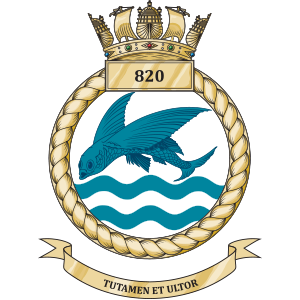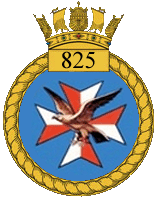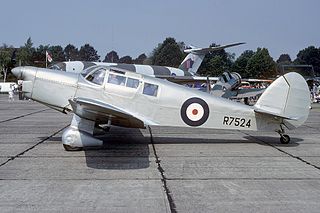
HMS Furious was a modified Courageous-class battlecruiser built for the Royal Navy (RN) during the First World War. Designed to support the Baltic Project championed by the First Sea Lord, Lord Fisher, the ship was very lightly armoured and designed with a main battery of only two 18-inch guns. Furious was modified as an aircraft carrier while under construction. Her forward turret was removed and a flight deck was added in its place, such that aircraft had to manoeuvre around the superstructure to land. Later in the war, the ship had her rear turret removed and a second flight deck installed aft of the superstructure, but this was less than satisfactory due to air turbulence. Furious was briefly laid up after the war before she was reconstructed with a full-length flight deck in the early 1920s. Her half-sisters Courageous and Glorious were also rebuilt as aircraft carriers around that time.

816 Naval Air Squadron was a Fleet Air Arm (FAA) naval air squadron of the United Kingdom’s Royal Navy (RN) which formed at the start of the Second World War.

701 Naval Air Squadron was a Fleet Air Arm (FAA) naval air squadron of the United Kingdom’s Royal Navy (RN), which last disbanded during September 1958 at RNAS Lee-on-Solent where it was a Helicopter Trials, Communications and Fleet Requirements Unit. It initially formed during July 1936 as a Catapult Flight operating out of Malta and routinely embarking in RN ships such as, HMS Barham, HMS Malaya, HMS Valiant and HMS Warspite. By autumn 1939 it was known as 701 Naval Air Squadron but disbanded in January 1940. It was active twice more during the Second World War, between May 1940 and June 1941 on special duties and then between October 1942 and August 1943 performing anti-submarine patrols. Reforming in April 1945 it was designated a Communications Unit, operating out of Heston until disbanding in 1947. It last reformed as a Fleet Requirements Unit at HMS Daedalus, Lee-on-Solent, during October 1957.

820 Naval Air Squadron is a Royal Navy Fleet Air Arm carrier-based squadron flying the AgustaWestland Merlin HM2 in Anti-Submarine and Airborne Early Warning (AEW) roles from RNAS Culdrose.
810 Naval Air Squadron was a Royal Navy Fleet Air Arm carrier based squadron formed on 3 April 1933 with the amalgamation of the 12 Blackburn Dart aircraft from 463 and 44 Flight Flights Royal Air Force to the Fleet Air Arm. The squadron saw action during the Second World War, the Suez Crisis and the Korean War.
818 Naval Air Squadron was a Royal Navy Fleet Air Arm carrier-based squadron formed in August 1939. It served on a number of the Navy's aircraft carriers during the Second World War, serving in most of the theatres of the war, before decommissioning at the end of the war.

825 Naval Air Squadron is a Royal Navy Fleet Air Arm Naval Air Squadron which was re-commissioned on 10 October 2014 and currently flies the AgustaWestland Wildcat HMA2.

828 Naval Air Squadron was a Royal Navy Fleet Air Arm carrier based squadron formed in September 1940 as a torpedo spotter reconnaissance squadron. It operated in a number of the theatres of the Second World War, carrying out a number of attacks on enemy targets including the Tirpitz in Norway.
812 Naval Air Squadron was a Naval Air Squadron of the British Royal Navy's Fleet Air Arm. It was active between 1933 and 1956, and saw service in both World War II and the Korean War.
822 Naval Air Squadron was a Fleet Air Arm aircraft squadron before and during World War II.
823 Naval Air Squadron was a Fleet Air Arm aircraft squadron before and during World War II.

826 Naval Air Squadron was a Fleet Air Arm aircraft squadron formed during World War II which has been reformed several times since then until last disbanded in 1993.

711 Naval Air Squadron was a Fleet Air Arm (FAA) naval air squadron of the United Kingdom’s Royal Navy (RN) which disbanded in December 1945. It was first formed from 447 (Catapult) Flight in 1936 and operated out of the Island of Malta, providing flights for the Royal Navy’s 1st Cruiser Squadron. By the beginning of World War II it had become a Squadron and was based in Egypt, but disbanded in 1940 when the Fleet Air Arm centralised the operations of the 700 series "Catapult" flights attached to catapult units. It reformed in September 1944 as a Torpedo Bomber Reconnaissance Training Squadron, based at HMS Jackdaw in Fife, Scotland, it was operational for just over one year before it was absorbed by 785 Naval Air Squadron.

713 Naval Air Squadron was a Fleet Air Arm (FAA) naval air squadron of the United Kingdom’s Royal Navy (RN) which was disbanded in late 1945. It was first formed from 445 Flight in 1936 and operated with Fairey Seafox floatplanes from RAF Kalafrana at the onset of the Second World War and subsequently integrated into 700 Naval Air Squadron in January 1940. The squadron was re-established at HMS Urley, RNAS Ronaldsway, Isle of Man, in December 1944, functioning as a Torpedo Bomber Reconnaissance Training Squadron, where it operated with Fairey Barracuda aircraft.

747 Naval Air Squadron was a Fleet Air Arm (FAA) naval air squadron of the United Kingdom’s Royal Navy (RN) which last disbanded in December 1945. 747 Naval Air Squadron was part of the Torpedo Bomber Reconnaissance Pool and formed at HMS Owl, RNAS Fearn, in March 1943, evolving into an Operational Training Unit. July saw the squadron move to HMS Nightjar, RNAS Inskip and became part of No. 1 Naval Operational Training Unit. It returned to HMS Owl in January 1944 and then to HMS Urley, RNAS Ronaldsway, in July. In November 1945 the squadron headquarters moved to HMS Jackdaw, RNAS Crail, leaving a Flight at HMS Urley.

756 Naval Air Squadron was a Fleet Air Arm (FAA) naval air squadron of the United Kingdom’s Royal Navy (RN). It was initially formed as a Telegraphist Air Gunner Training Squadron, operating from May to August 1939, out of RNAS Worthy Down, in Hampshire, England. It was later reformed again as a Telegraphist Air Gunner Training Squadron, operating from March 1941, out of RNAS Worthy Down. TAG training was provided until the No. 2 School was ready in Canada, opening on 1 January 1943, and 756 Naval Air Squadron disbanded in December 1942. The squadron reformed at RNAS Katukurunda, in Sri Lanka, in October 1943, as a Torpedo, Bomber, Reconnaissance pool. During 1944 and 1945, the squadron undertook a number of detachmemts on different types of Royal Navy aircraft carriers, then disbanding in December 1945.

763 Naval Air Squadron was a Fleet Air Arm (FAA) naval air squadron of the United Kingdom’s Royal Navy (RN). It formed in 1939 as the Torpedo Spotter Reconnaissance Pool No. 1, at HMS Kestrel, RNAS Worthy Down. Three months later, it moved to the short-lived RNAS Jersey, in the Channel Islands, before moving back to Worthy Down via HMS Daedalus, RNAS Lee-on Solent and disbanded in 1940. The squadron reformed, on the seaplane carrier HMS Pegasus, as a Seaplane Training Squadron, in 1942. This role lasted around two years and the squadron continually operated and provided training from HMS Pegasus, until disbanding in 1944. Roughly two months later, the squadron reformed again, this time at HMS Nightjar, RNAS Inskip, as an Anti-submarine Operational Training Squadron and remained in this role for just over one year, disbanding in July 1945.

783 Naval Air Squadron was a Fleet Air Arm (FAA) naval air squadron of the United Kingdom’s Royal Navy (RN) which last disbanded in November 1949. 783 Naval Air Squadron was formed as an ASV Training Squadron at HMS Condor, RNAS Arbroath, Scotland, in January 1941. It operated a number of ‘flying classroom’ aircraft alongside other types. It operated in conjunction with the Naval Air Signals School (NASS) from March 1943. The squadron moved to HMS Daedalus, RNAS Lee-on-Solent, England, when the NASS moved south, also supporting the Flag Officer, Air, Home Communications Officer and from July 1948,it was part of the 51st Miscellaneous Air Group.

785 Naval Air Squadron was a Fleet Air Arm (FAA) naval air squadron of the United Kingdom’s Royal Navy (RN) which disbanded in early 1946. 785 NAS formed as a Torpedo Bomber Reconnaissance Training Squadron, at HMS Jackdaw, RNAS Crail, in November 1940. Throughout its existence it operated a number of various types of torpedo bomber aircraft. The squadron became part of No. 1 Naval Operational Training Unit in late 1944.

786 Naval Air Squadron was a Fleet Air Arm (FAA) naval air squadron of the United Kingdom’s Royal Navy (RN) which last disbanded in late 1945, absorbed by 785 Naval Air Squadron. 786 NAS formed at HMS Jackdaw, RNAS Crail, in November 1940, as a Torpedo Bomber Reconnaissance squadron. It operated a few different types of torpedo bomber aircraft, initially equipped with Fairey Albacore and shortly afterwards joined by Fairey Swordfish, these aircraft were replaced by Fairey Barracuda at the of 1942.













